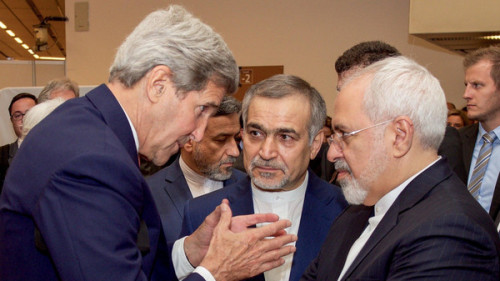PHOTO: US Secretary of State John Kerry and Iranian Foreign Minister Mohammad Javad Zarif, July 14, 2015
Arms control specialist Jeffrey Lewis writes for Foreign Policy magazine:
See also Iran Special: A 5-Point Guide to the Nuclear Agreement
Iran Analysis: Nuclear Deal — Understanding A Victory That Comes With Costs
…The deal — can we call it the “Vienna Plan,” please? — looks pretty much like the framework deal that was reached in Lausanne in April. I went through the documents, including the White House fact sheet, as well as my own notes from conversations with administration officials. It would seem that the agreement is as good or better in all important respects than what officials described in the spring.
The reduction in centrifuges remains substantial — the limits are the same as those reported when the framework was announced. Moreover, little worries I had, like whether Iran would agree to remove piping and other infrastructure along with the centrifuges themselves, were resolved favorably.
The Vienna Plan also provides a path to resolve the outstanding issues with the International Atomic Energy Agency regarding Iran’s past covert nuclear weapons program (known delicately as “possible military dimensions”) and provides a public description of something U.S. officials had only described in private — a R&D schedule that limits Iran’s development of new centrifuges over the next eight to 10 years.
And, if like me you think “breakout” or the time it would take to turn nuclear material into one bomb, is a dumb measure, the agreement also has lots of provisions to deal with “sneak-out,” or an attempt to get a bomb covertly. These provisions include granting inspectors access to military sites and monitoring of centrifuge workshops and uranium mines. But this shouldn’t be a surprise: It was in the bag in Lausanne.
It is worth looking at this chart issued by the Supreme Leader’s office showing all his “red lines” in the talks. It turns out the Iranians gave in on several of them and found rather creative solutions to a few others. You can make your own list, but I think they compromised on (1, 3, 5, 7, 8, and 9):
What had to be resolved in Vienna was the tricky issue of sanctions. It was always clear that there would have to be an implementation period so that Iran could say sanctions came off “immediately” while the United States could claim the opposite.
One of the amazing things is how many of the pearl-clutching stories about how the agreement was going off the rails turned out to be nonsense. Most of these were written by the New York Times’ David E. Sanger, and they won’t age well….


